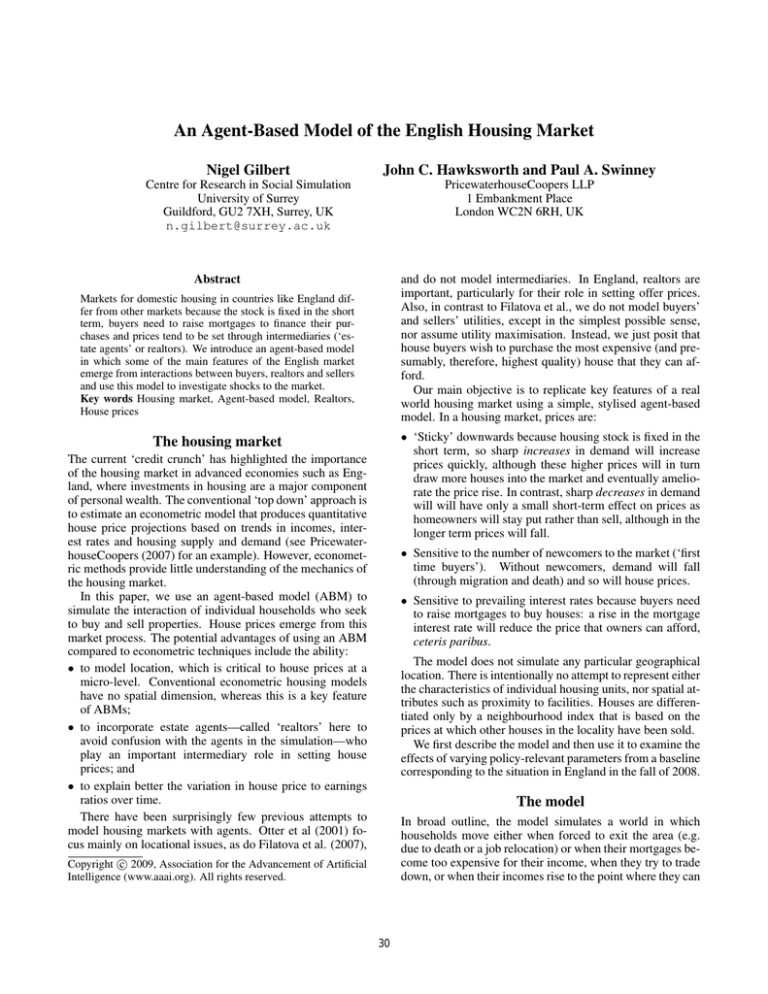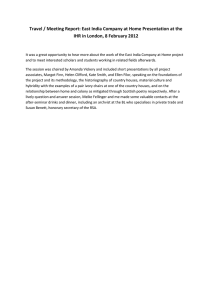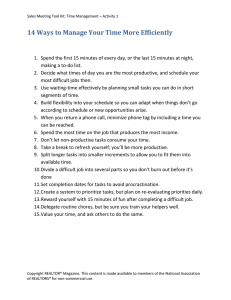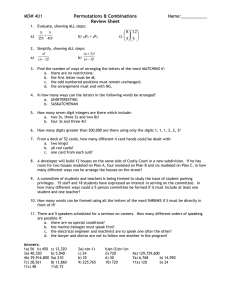
An Agent-Based Model of the English Housing Market
Nigel Gilbert
John C. Hawksworth and Paul A. Swinney
Centre for Research in Social Simulation
University of Surrey
Guildford, GU2 7XH, Surrey, UK
n.gilbert@surrey.ac.uk
PricewaterhouseCoopers LLP
1 Embankment Place
London WC2N 6RH, UK
and do not model intermediaries. In England, realtors are
important, particularly for their role in setting offer prices.
Also, in contrast to Filatova et al., we do not model buyers’
and sellers’ utilities, except in the simplest possible sense,
nor assume utility maximisation. Instead, we just posit that
house buyers wish to purchase the most expensive (and presumably, therefore, highest quality) house that they can afford.
Our main objective is to replicate key features of a real
world housing market using a simple, stylised agent-based
model. In a housing market, prices are:
Abstract
Markets for domestic housing in countries like England differ from other markets because the stock is fixed in the short
term, buyers need to raise mortgages to finance their purchases and prices tend to be set through intermediaries (‘estate agents’ or realtors). We introduce an agent-based model
in which some of the main features of the English market
emerge from interactions between buyers, realtors and sellers
and use this model to investigate shocks to the market.
Key words Housing market, Agent-based model, Realtors,
House prices
• ‘Sticky’ downwards because housing stock is fixed in the
short term, so sharp increases in demand will increase
prices quickly, although these higher prices will in turn
draw more houses into the market and eventually ameliorate the price rise. In contrast, sharp decreases in demand
will will have only a small short-term effect on prices as
homeowners will stay put rather than sell, although in the
longer term prices will fall.
The housing market
The current ‘credit crunch’ has highlighted the importance
of the housing market in advanced economies such as England, where investments in housing are a major component
of personal wealth. The conventional ‘top down’ approach is
to estimate an econometric model that produces quantitative
house price projections based on trends in incomes, interest rates and housing supply and demand (see PricewaterhouseCoopers (2007) for an example). However, econometric methods provide little understanding of the mechanics of
the housing market.
In this paper, we use an agent-based model (ABM) to
simulate the interaction of individual households who seek
to buy and sell properties. House prices emerge from this
market process. The potential advantages of using an ABM
compared to econometric techniques include the ability:
• to model location, which is critical to house prices at a
micro-level. Conventional econometric housing models
have no spatial dimension, whereas this is a key feature
of ABMs;
• to incorporate estate agents—called ‘realtors’ here to
avoid confusion with the agents in the simulation—who
play an important intermediary role in setting house
prices; and
• to explain better the variation in house price to earnings
ratios over time.
There have been surprisingly few previous attempts to
model housing markets with agents. Otter et al (2001) focus mainly on locational issues, as do Filatova et al. (2007),
• Sensitive to the number of newcomers to the market (‘first
time buyers’). Without newcomers, demand will fall
(through migration and death) and so will house prices.
• Sensitive to prevailing interest rates because buyers need
to raise mortgages to buy houses: a rise in the mortgage
interest rate will reduce the price that owners can afford,
ceteris paribus.
The model does not simulate any particular geographical
location. There is intentionally no attempt to represent either
the characteristics of individual housing units, nor spatial attributes such as proximity to facilities. Houses are differentiated only by a neighbourhood index that is based on the
prices at which other houses in the locality have been sold.
We first describe the model and then use it to examine the
effects of varying policy-relevant parameters from a baseline
corresponding to the situation in England in the fall of 2008.
The model
In broad outline, the model simulates a world in which
households move either when forced to exit the area (e.g.
due to death or a job relocation) or when their mortgages become too expensive for their income, when they try to trade
down, or when their incomes rise to the point where they can
c 2009, Association for the Advancement of Artificial
Copyright Intelligence (www.aaai.org). All rights reserved.
30
Figure 1: The user interface of the model, showing the parameters that can be changed, the neighbourhoods that emerge, and
the output plots. The original is in colour (contact the first author for a colour version of the figures). The six large light grey
(yellow) spots are the realtors. The cells shaded from dark grey (blue) to very light grey (red) are houses coded by their last
selling price. Those with grey dots in the centre of the cells are occupied; the others are vacant. Medium grey (green) cells are
parkland.
Rate) are initially vacant and available to buy (at prices set
by the highest valuation of the realtors covering the relevant
area as explained below). The values of the houses (as indicated by price) is initially distributed either randomly (i.e.
with a uniform random distribution), stratified according to
their distance from the south-west corner, or randomly clustered, as indicated by InitialGeography. Houses also
have a quality index, set at the time they are constructed,
which is the ratio of the average of the prices of other houses
in the locality to this house’s sale price.
comfortably afford a more expensive house. Having decided
to sell, they approach one or more nearby realtors for valuations, which are based on the realtor’s experience of recent
price levels in that locality. The seller puts the house on the
market at the highest valuation initially but reduces the price
later if it does not sell. Buyers look for a house that best
fits their income level and make an offer. But offers only go
through if chains do not break down, just as in real life. The
model works out which chains of offers remain intact and
these people then move. Other offers fail as chains collapse.
New entrants become discouraged and leave the area after
a certain period if they cannot find a property that matches
their income.
In more detail (names in plain font correspond to parameters of the model that can be varied, see Figure 1):
Sellers
Each period a random ExitRate per cent of homeowners
exit the ‘town’ and have to sell at the price set by the realtor
as described below. If they cannot sell in the current period,
their house remains empty and on the market.
Each homeowner initially has an income selected at random from a Gamma distribution (Salem and Mount 1974)
with parameters 1.3 and 5 × 10−5 multiplied by the setting
of MeanIncome, and a mortgage of value equal to the ratio
of Affordability to the InterestRate multiplied
Grid
There is a ‘town’ grid of 50 × 50 plots, of which Density
have houses on them and (1 − Density) are non-housing
(e.g. parks and fields).
Of the houses, some proportion (InitialVacancy
31
deposit to hand). They can also put any capital that they
have gained from selling a previous house towards the cost
of their desired property. They then choose the one property that comes closest to their maximum affordable price,
and make an offer at the price set by the seller. Thus the first
buyer to make an offer on a property has their offer accepted.
If an entrant has failed to purchase a house for
MaxHomelessPeriod periods after entry, it exits.
by the homeowner’s income. It is assumed that initial house
purchases are mortgage-financed using a repayment mortgage of duration MortgageDuration (e.g. 25 years).
Borrowers have to find a deposit from their own resources
in addition to the mortgage. The amount of deposit is determined by the MaxLoanToValue.
Each period Shocked per cent of homeowners face an
income shock of +20 per cent and the same percentage of
homeowners a shock of -20 per cent. This means that their
income is suddenly and permanently raised or lowered by
this percentage.
Homeowners trade down when the ratio of their mortgage
repayment to their income becomes greater than twice the
Affordability and trade up when the ratio becomes
less than half the Affordability—they are then ‘sellers’.
When they decide to trade, sellers contact all realtors in
the area covering their home and ask for valuations. They
select the highest valuation, which is the sale price.
Transactions
An offer only turns into a successful sale if the house being bought is either already empty, or the seller succeeds in
moving to another house that they have purchased. Hence,
transactions can fail if the chain cannot complete.
The exiters move out of their houses and potential buyers (if any) that made successful offers for the now empty
houses move in. The purchasers’ houses are then moved
into by those who had made offers for them and so on down
the chain. Once all possible transactions are complete, the
next time step starts.
When a house is sold, the seller gets the sale price and
immediately uses as much of this as necessary to pay off any
remaining mortgage. If money remains after paying off the
mortgage, this capital can be used as partial or full payment
for the house the seller is moving into. If the sale price is
insufficient to pay off the mortgage, the seller is in a position
of ‘negative equity’ and has to withdraw the house from the
market.
The realtor concerned records details of successful sales
and uses these records when valuing houses within the same
Locality.
If an offer fails to go through in one period, it immediately
lapses.
Realtors
There are three designated areas of the town, each with a
centre and with overlapping radiuses of coverage together
encompassing most of the town. Realtors are located in
the centre of each area, two to an area, to represent clustering. Most houses will therefore be covered by at least
two realtors. Realtors have a radius of coverage given by
RealtorTerritory. Houses not in a realtor’s territory
take their valuations from the nearest realtor.
Realtors know the prices of all houses they have recently
sold. At the beginning of the simulation run, the mortgage
value of each house is lodged with one local realtor, to give
realtors an initial starting point for their valuations.
When asked for a valuation after the first period, the realtors use the median prices of houses that they have sold in
the last RealtorMemory periods that are within a certain
radius of the house for sale (the Locality) multiplied by
the house’s quality index. If a realtor has no sales in the locality, it uses the median price of all sales in the Locality
(whenever they were made) or if there are no sales, the average price of all houses in its territory. The valuation is
boosted by a RealtorOptimism factor (e.g. 3 per cent),
which allows for realtors hoping that they can sell for more
than the going rate.
If a house fails to sell during a period, the selling price is
reduced by PriceDropRate per cent and it continues to
be on the market for the next period and until it is sold or
demolished.
New build and demolition
At each time step, new houses are added to the
town at random empty locations, at a rate of
HouseConstructionRate per cent of the existing
housing stock, unless there are no empty plots. A house
has a lifetime set at the time of its construction, drawn
from a random exponential distribution with a mean of
HouseMeanLifeTime. At the end of its life, it is
demolished and the plot becomes vacant again and available
for house building. A house is also demolished if its sale
price falls below one tenth of the median price of all houses.
If there is someone living in a house being demolished, they
attempt to buy another house and if they have not succeeded
after MaxHomelessPeriod timesteps they leave the
town.
Buyers
Each period there are new entrants to the town equalling
EntryRate per cent of the existing population of homeowners.
The new entrants and non-exiting sellers search randomly
across the whole town for BuyerSearchLength properties that are for sale, for which no offer has yet been made,
and that they can afford (i.e., those for which their mortgage
repayment would not be greater than the Affordability
for their income and for which they would have a sufficient
Macroeconomic variables
As well as the (mortgage) InterestRate, a rate for
(wage) Inflation can be set. Both these are measured
in per cent per year. The time represented in the model can
be calibrated in TicksPerYear (i.e. timesteps per year).
The interest rate may be periodically varied (along a sine
wave) by varying CycleStrength.
32
Display
Houses are assigned a colour taken from one of ten shades
from blue to red according to their price (based on last transaction, or mortgage value initially), see Figure 1.
There are time plots of:
• The total number of houses, the number that are empty,
and the number that are being demolished at each time
step
• The number of people without a house who are seeking
one and the number in a house, but with negative equity
• The total number of people in the town, and the numbers
who are moving because the ratio of their mortgage repayments to their income is greater than twice or less than
half the Affordability ratio
• Median house prices and median incomes (and the ratio
between the two)
• Measures of income and house price inequality (Gini coefficients)
• Transaction volumes
• The median time that a house for sale is on the market
before it is sold or withdrawn from sale.
For the current time period, there are histograms for
• the distribution of incomes and house prices
• the distribution of capital accumulated by owners selling
houses.
Figure 2: The effect of an abrupt change in the mortgage
interest rate at time step 360 on a range of market features
The behaviour of the model
The model is written in NetLogo (Wilensky 1999) and may
be run as an applet on the web at http://cress.soc.
surrey.ac.uk/housingmarket/ukhm.html. Our
objective was to reproduce the main characteristics of the
market as listed above. This has been achieved. Some examples1 are described below. The examples are based on
model parameters that have been calibrated to match approximately the actual English situation in the early fall (autumn)
of 2008.
1. The price elasticity with respect to the prevailing interest rate is −1.03 (Figure 2). Thus a 43 percent increase
in the interest rate (from 7 to 10 percent) results the median house price falling by 47 per cent, with an immediate
sharp decrease in the number of transactions and the ratio
of mean house prices to mean income reduced from about
5.5 to about 3.6. This is the result of buyers finding that
they cannot afford more expensive houses, driving down
demand and thus the market price.
2. First time buyers compensate for the drain of owners who
leave due to migration or death. If prices are too high, the
newcomers cannot find a property to buy and eventually
leave, discouraged, which drives down prices (for example, if the newcomers have an income 20 per cent less than
the incumbents, £24,000 compared with £30,000, the median house price drops by about the same ratio, see Figure
3).
Figure 3: The effect of an abrupt 20 per cent decrease in the
income of newcomers at time step 360 on a range of market
features
3. A large demand shock (e.g. a surge of 500 newcomers
into a market of 2,200 houses) produces an immediate
general increase in house prices of about 30 per cent and
a near doubling of the price to income ratio, which slowly
returns to normal as more houses come onto the market.
Conclusions from the model
By starting the simulation with a ‘baseline’ set of parameters
and then varying one of the parameters while the simulation
is running, we can examine the sensitivity of indicators such
as the median house price to exogenous economic and policy
changes. A baseline parameter set of:
1. mortgage interest rate: 7%
2. maximum loan to value ratio: 100%
3. new entrants to the town have the same distribution of
income as the residents
1
Although the model is stochastic, the variations between runs
are small compared with the qualitative effects described below.
4. housebuilding is at the rate of 0.33% of the housing stock
in each period
33
Figure 4: House price to earnings ratio in response to an interest rate increase at period 200 from 7% to 10%
was used. With this baseline model, we see that both house
prices and the number of housing transactions tend to be
volatile in the short term (see Figure 2, helping to explain
why short-term housing market forecasts are often subject
to significant margins of error.
Other interesting conclusions that can be drawn from the
model include:
• Even when starting a run with a ‘random’
InitialGeography, where house quality and
owners are randomly distributed across the town, clusters
or ‘neighbourhoods’ of high priced and low priced
houses tend to emerge (see Figure 1 for an example).
This is because high priced houses in a locality raise the
prices of other houses around them by in uencing the
valuations given by realtors in the neighbourhood. These
relatively expensive houses attract relatively rich owners,
creating a well-off neighbourhood. The reverse is true
for poor neighbourhoods. The positions of the clusters
is entirely random and varies for each run. By setting
the InitialGeography to ‘clustered’, a starting
configuration with neighbourhoods can be created for
the simulation and thee neighbourhoods are maintained,
more or less, as the simulation runs. If certain areas had
natural advantages (such as pleasant surroundings or easy
access to facilities), one would expect neighbourhoods
would crystallise around them and this is likely to be the
way real neighbourhoods form and persist, changing only
slightly across centuries.
In the longer term, average house prices tend to show a
stable relationship to average income levels for given levels
of mortgage interest rates and loan-to-value ratios; if interest rates fall or maximum loan-to-value ratios rise, then the
equilibrium house price to income ratio rises in response.
This can be seen in Figure 4. The upper line shows the
effect of a change in interest rate from 7% to 10% with a
loan-to-value ratio of 100%. As expected, the rate change
induces a sharp drop in prices. However, if we now alter
the maximum loan to value ratio to 80%, the effect of an
interest rate change from 7% to 10% is modest (see Figure
4). That is, the interest rate effect on house prices is much
weaker when the maximum loan-to-value ratio is lower; in
particular, the model suggests that moving from a 100% to
an 80% maximum loan-to-value ratio can have a major depressing impact on house prices through keeping first-time
buyers with limited savings out of the housing market and
this can outweigh any positive effects on house prices and
transactions volumes from interest rate cuts.
• Adding wage in ation does not change the qualitative behaviour of the model: all prices rise in parallel with the
in ation, but the shape of the house price distribution and
the Gini indices do not change.
With an 80% maximum loan-to-value, new entrants to the
market are mostly constrained by their ability to find a deposit of at least 20% and only secondarily by their ability to
afford interest repayments. Interest rate rises do still have
some downward in uence on house prices, but it is much
less marked in this case as the lower line in Figure 4 shows.
Hence, if, as has happened during 2008, maximum loan-tovalue ratios are reduced from 100% to, say, around 80% then
this will not only reduce house prices significantly but may
also reduce the significance of mortgage interest rate cuts
in potentially reviving the market—if first-time buyers (and
other households with limited savings) cannot afford a deposit, then the mortgage interest rate does not matter much
to them.
• Adding the British stamp duty land tax (a tax levied on
house sales, which rises as a percentage as the price of
the property increases) to the simulation shows that altering the rate of duty has a barely detectable effect on
house prices. If, for example, stamp duty is set at 1%
rather than zero then the impact is effectively lost in the
short-term noise seen in house prices. The implication
is that the temporary holiday on the 1% stamp duty rate
for houses between £125,000 and £175,000 that was announced in early September 2008 seems unlikely to have
had more than a marginal impact on English house prices
34
compared with other market drivers like actual and expected household income levels, mortgage interest rates
and credit availability.
Much the same applies to the impact of varying other
fixed costs of moving, such as realtor’s fees and removal
costs.
Wilensky, U.
1999.
Netlogo.
northwestern.edu/netlogo/.
• Shocks to the market can generate long-lasting oscillations, giving the effect of emergent cycles of boom and
bust. An example can be seen in Figure 2 after the change
in interest rate at step 360.
Developments
The aim of the model is to investigate the complicated interactions that create a housing market, and so it is desirable for
the model to be as simple as possible, while showing the required emergent behaviour. There are a number of features
of real housing markets yet to be studied: some of them may
prove to be important and others less so. These include:
• the rental sector
• repossessions and forced sales
• house building that responds to demand, but with a lag for
construction
• endogenising the mortgage interest rate, so that it responds to demand
• the effects of competition between realtors: those more
successful in selling houses would benefit from increased
profits and be able to increase their radius of coverage.
It may also be necessary to reproduce a real location in
order to validate the model and to account for spatial effects
such as distance to urban centres and jobs. Nevertheless,
we have demonstrated that the agent-based modelling of a
housing market is both possible and potentially useful.
Acknowledgement
We are grateful to Lynne Hamill for her constructive comments and help.
References
Filatova, T.; van der Veen, A.; and Parker, D. C. 2007.
Modeling of a residential land market with a spatially explicit agent-based land market model (ALMA). In 2nd
Workshop of Market Dynamics SIG.
Otter, H. S.; van der Veen, A.; and de Vriend, H. J. 2001.
ABLOoM: Location behaviour, spatial patterns, and agentbased modelling. J. of Artificial Societies and Social Simulation 4(4):2. http://jasss.soc.surrey.ac.
uk/4/4/2.html.
PricewaterhouseCoopers.
2007.
UK economic
outlook November 2007.
Technical report.
http://www.pwc.co.uk/pdf/uk_economic_
outlook_sec4_nov07.pdf.
Salem, A. B. Z., and Mount, T. D. 1974. A convenient descriptive model of income description: the gamma density.
Econometrica 42:1115–1127.
35
http://ccl.




